For National Public Gardens Day, we packed up and traveled to a local garden. It was free in honor of the day, but truth be told, I would have paid for it. It was worth an admittance fee.
The gardens we visited were cultivated with local flora. Many species of flowers were in bloom and created beautiful vistas for our walk.
Along our walk, volunteers had set up numerous learning stations. Among them was a lesson about pollinators and the process of pollination. One of the hands on activities children were encouraged to do was pollinate flowers with a bee.
Children received a small bee fashioned from yellow and black chenille pipe cleaners.
The bee fit on a child's pointer finger.
Each child was then asked to 'fly' the bee to different large (fake) flowers set up in the grassy lawn.
As the children flew their bees onto each flower, the bee would become coated with 'pollen' (a corn meal-like mixture).
Taking the pollen from one flower to the next provided each child with a hands on pollinating experience. Not to mention it was fun!
My only disappointment was not having this idea before I taught about bees during co-op science. However, as I'll be teaching botany to first and second graders next year, this is one hands on learning activity I want to include.
Related:
Experiments on Insects
Ladybug Observations
Ladybug Craft - Demonstrating Both Sets of Wings
Showing posts with label Preschool. Show all posts
Showing posts with label Preschool. Show all posts
How I May Have Failed Teaching Preschool
I look about and see some serious lesson plans for preschool aged children. They are amazing! But, I wonder, are they necessary?
When I was a little one, I went to a preschool. My only memory is having my blankie taken from me, as it was decidedly not allowed in the classroom. I am sure I learned a great deal of foundational information in my preschool years. By the time I started Kindergarten, I could count to 100, read, and name all the colors. Someone taught me those things, but whether I learned them at home or in a classroom I don't remember. However, preschool was different then. It has changed dramatically over the years.
Now, my nephew, who has yet to hit the preschool years, has learned colors and is counting. The trend to teach them young is wide spread. Day cares, preschools, and homeschoolers alike are teaching their children with set curricula as early as one year, perhaps even before.
Still, I wonder, is it necessary?
When I consider what I observe through personal experience, societal trends, scopes & sequences, and the online community, I think perhaps I may not have taught preschool in the most popular way.
In fact, on a side by side comparison, our children's preschool experiences possibly look less than.
What our preschool did not include:
What our preschool did include:
Looking over the lists and adding the pictures has got me thinking that perhaps, just maybe, our children's preschool years were not less than, but rather they were truly more than.
Wondering what curriculum we did use during preschool? Find it here.
Want to see some an example of our preschool unit studies? Click here or here.
When I was a little one, I went to a preschool. My only memory is having my blankie taken from me, as it was decidedly not allowed in the classroom. I am sure I learned a great deal of foundational information in my preschool years. By the time I started Kindergarten, I could count to 100, read, and name all the colors. Someone taught me those things, but whether I learned them at home or in a classroom I don't remember. However, preschool was different then. It has changed dramatically over the years.
Now, my nephew, who has yet to hit the preschool years, has learned colors and is counting. The trend to teach them young is wide spread. Day cares, preschools, and homeschoolers alike are teaching their children with set curricula as early as one year, perhaps even before.
Still, I wonder, is it necessary?
When I consider what I observe through personal experience, societal trends, scopes & sequences, and the online community, I think perhaps I may not have taught preschool in the most popular way.
In fact, on a side by side comparison, our children's preschool experiences possibly look less than.
What our preschool did not include:
- a set classroom with everything geared toward a three or four year old
- sensory bins
- kids' music {for example, I did not sing Wheels on the Bus}
- library story time
- art projects worthy or an art museum display
- classes {out of the house}
- Please Touch Museums or any place specific to preschoolers
- following a specific all encompassing, packaged preschool curriculum
- adherence to a strict schedule
What our preschool did include:
- a home environment with a small table and chair for our preschooler
- nature walks, including encouragement to explore and observe the outdoors
- Christian praise music and classical music
- books of all kinds read aloud
- basic ABCs and 123s {sounds and counting included}
- fun, sometimes messy, art projects
- play groups with children of all ages
- unit studies I devised
- encouragement for the preschooler to join the older children whenever he/she wanted
- times of learning experiences incorporated into our days
Looking over the lists and adding the pictures has got me thinking that perhaps, just maybe, our children's preschool years were not less than, but rather they were truly more than.
Wondering what curriculum we did use during preschool? Find it here.
Want to see some an example of our preschool unit studies? Click here or here.
Categories:
Preschool
Art Appreciation for Young Students
We were at the library {shocking I know!} and during a search for a book on knitting, I found three new-to-us art appreciation books for younger students. All three are by the same author, Bob Raczka, and personally, I recommend all three!
Three great art appreciation books:
Art Is... by Bob Raczka begins each thought with the title and tells readers what art is. Each attribute is accompanied by a well known piece of art. The author does not limit his selections to famous paintings and sculptures. He includes fabric tapestries, buildings and even lamps. For instance, when he says it is "enlightening," the picture displays a beautiful table lamp by Tiffany.
No One Saw: Ordinary Things Through the Eyes of an Artist, by Bob Raczka capitalizes on the idea that we each individually see and experience the world uniquely. Thus, our art work, and the art work of famous artists reflects what we see and experience. The text is arranged to have a rhythmic flow with quite a few rhymes of artists' last names as well. This book predominately pictures paintings.
Unlikely Pairs: Fun with Famous Works of Art, by Bob Raczka is one unique book! My youngest son and I enjoyed the quirky and quite unlikely pairing of famous paintings. Most combinations presented a humorous take on the connection between the two art works. Whether it be a continuation of the pictures or a similar subject, the end result was a different, but creative way to connect art work from different time periods and styles.
Categories:
Art,
Art Appreciation,
Books,
Elementary,
Preschool
The Preschool A to Z Year
It is most likely our last preschool year, as our youngest will start kindergarten next school year and we currently have no babies in the house. Even though our children don't go off to school, we still 'mourn' the loss of the preschool years, but we anticipate with joy a new chapter in our family's life.
Last week, our youngest finished his last year of preschool learning. In this time, our children learn letters and sounds, from A to Z, numbers and counting, and simple mathematical concepts. We also like to introduce our preschoolers to basic concepts in science, history, and the arts. These are generally not formal lessons, but from time to time, our younger children have had unit lessons based on on books or historical time periods. When the material is applicable, our preschoolers have participated in the group lessons alongside of our older children. The younger children often absorb quite a lot of information during these times. We also try to incorporate fun activities and art projects into the preschool days.
With the winding down of our final preschool year, I thought it might be nice to record our main resources for teaching preschool. We find
A few of our favorite preschool resources are:
Get Ready for the Code, Explode the Code Primer, Book A, by Nancy Hall
Get Set for the Code, Explode the Code Primer, Book B, by Nancy Hall
Go for the Code, Explode the Code Primer, Book C, by Nancy Hall
Christian Liberty Preschool Activity Book, by Sherry Kurz, Florence Lindstrom, and Barbara Beal
Christian Liberty Preschool Drill Book, by Sherry Kurz
Christian Liberty Nature Reader, Book K, by Florence M. Lindstrom
Two Kindergarten resources that we use in the A to Z year of preschool are:
Saxon Math, Level K, by Nancy Larson
A Reason for Handwriting, Level K, by Carol Ann Retzer
Related Posts:
Three ABC Bible Resources for Young Learners
Three ABC Bible Resources for Young Learners
Throughout the years, each of our children has started learning to read by first learning their ABC's. For me, it is fun to try to incorporate the ABC's into as many subjects as possible. During that prekindergarten time, our children are immersed in the ABC's. We even use a few ABC Bible resources. Three of our favorites are:
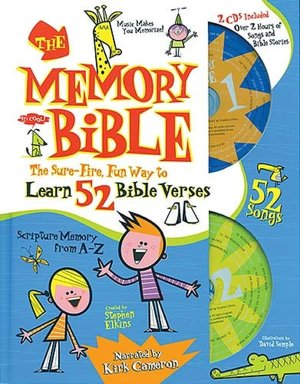
The Memory Bible: Learn 52 Bible Verses, created by Stephen Elkins
Bible Stories From A to Z (ages 5-9), by Mary Murray
Sing the Word from A to Z, by Anne & Steve Harrow
The Memory Bible: Learn 52 Bible Verses offers a little of everything all within 52 short devotionals. The book is set up alphabetically. Twice the book goes through the alphabet (capital and small letters). Each letter has a memory verse, devotional story, Bible passage, and song. The accompanying CDs are narrated by Kirk Cameron. The CDs only have the Bible verse, passage, and song for each letter.
For a more hands on approach, we use Bible Stories from A to Z, by Mary Murray. It is a workbook with 26 lessons, one for each letter of the alphabet. Each lesson focuses on one aspect or story from the Bible. Along with the story, there are questions, craft suggestions, and simple worksheets. The pages are reproducible and easy to use with multiple children.
Our family's favorite alphabetical songs are found on Sing the Word from A to Z. What a fabulous way to hear and learn Scripture! The Harrow family has assembled a lovely CD. Seven years after my oldest son learned the songs, he still sings along with them when we play the CD for his younger brother.

The Memory Bible: Learn 52 Bible Verses, created by Stephen Elkins
Bible Stories From A to Z (ages 5-9), by Mary Murray
Sing the Word from A to Z, by Anne & Steve Harrow
The Memory Bible: Learn 52 Bible Verses offers a little of everything all within 52 short devotionals. The book is set up alphabetically. Twice the book goes through the alphabet (capital and small letters). Each letter has a memory verse, devotional story, Bible passage, and song. The accompanying CDs are narrated by Kirk Cameron. The CDs only have the Bible verse, passage, and song for each letter.
For a more hands on approach, we use Bible Stories from A to Z, by Mary Murray. It is a workbook with 26 lessons, one for each letter of the alphabet. Each lesson focuses on one aspect or story from the Bible. Along with the story, there are questions, craft suggestions, and simple worksheets. The pages are reproducible and easy to use with multiple children.
Our family's favorite alphabetical songs are found on Sing the Word from A to Z. What a fabulous way to hear and learn Scripture! The Harrow family has assembled a lovely CD. Seven years after my oldest son learned the songs, he still sings along with them when we play the CD for his younger brother.
Categories:
Alphabet,
Bible,
Elementary,
Preschool
A Colonial ABC Lesson
Searching the shelves of the library for a misplaced book led to finding a fun ABC book about Colonial Williamsburg.
The book is called D is for Drums: A Colonial Williamsburg ABC, by Kay Chorao. Each page incorporates a large letter into the illustration. There are many items on each page. Some were easily recognizable to our preschooler, but others like apothecary shop, cooper, ice house, and quoits needed some explanation. A glossary at the end of the book helps define every single term, including common ones like chairs and dolls. Instead of just a simple definition, the glossary offers tidbits of information as to how the object was used or what its significance was during colonial times.
While I read aloud the book, my preschooler shaped our hotch potch doll into the letter for each page following the guide in the book. On the bottom of each page, a small cartoon shaped hotch potch doll is shaped into that particular letter. He followed it as a guide.
Afterwards he played quiots.
Then we played with our Alpha Dice game.
Although I am not quite sure if this final game is from colonial times, or a modern game made to look like a game from colonial times. Either way, we had fun and our preschooler learned more about colonial times.
The book is called D is for Drums: A Colonial Williamsburg ABC, by Kay Chorao. Each page incorporates a large letter into the illustration. There are many items on each page. Some were easily recognizable to our preschooler, but others like apothecary shop, cooper, ice house, and quoits needed some explanation. A glossary at the end of the book helps define every single term, including common ones like chairs and dolls. Instead of just a simple definition, the glossary offers tidbits of information as to how the object was used or what its significance was during colonial times.
While I read aloud the book, my preschooler shaped our hotch potch doll into the letter for each page following the guide in the book. On the bottom of each page, a small cartoon shaped hotch potch doll is shaped into that particular letter. He followed it as a guide.
Afterwards he played quiots.
Then we played with our Alpha Dice game.
Although I am not quite sure if this final game is from colonial times, or a modern game made to look like a game from colonial times. Either way, we had fun and our preschooler learned more about colonial times.
One of Grimm's Tales in Two Picture Books
Recently, I have been searching through the library picture book shelves for Brother Grimm tales and found two versions of The Elves and the Shoemaker. The version retold by John Cech was similar to the version I remember from my childhood. The accompanying illustrations were slightly rough looking, with pencil markings and lines. A few were in a pen and ink style. This lent to a somewhat eerie feel to the book, something that seems to go hand and hand with most Grimm tales.
For a more comical version, we read The Bootmaker and the Elves, by Susan Lowell. This story offered more than a few humorous twists and turns to the original fairy tale. A definite western feel was achieved with the illustrations and words like moseyed, buckaroo, and swaggering. There were comical characters like an 'old cowpoke' and a tall, lean, bowlegged man. Overall, though it wasn't completely true to the original, it told the same basic story line, and had us laughing.
Linked to Read-Aloud Thursday at Hope Is the Word
Categories:
Elementary,
Picture Books,
Preschool,
Read Aloud
The Mitten - A Folktale and Mini Preschool Unit
An old Ukrainian folktale called The Mitten tells of a mitten lost on a cold winter's day. Slowly, one by one, the animals of the forest climb into the mitten. Eventually, the mitten, bursting at the seams, can hold no more. It busts open. All the animals scatter and the mitten is found, broken into pieces.
We read several versions of the folktale. Each altered the details slightly, but the main idea remained intact. Every reading delighted our youngest son. He laughed as the animals moved and squeezed to get inside the mitten, and laughed harder when the mitten burst open.
Since he enjoyed the folktale so much, I added a few learning activities based on, or related to, the story.
He completed some worksheets and an activity from Enchanted Learning. Several were focused on reading sight words and recognizing beginning consonant sounds. Others involved matching and counting. Then, we made a mitten to reenact the story by stuffing pictures of forest animals inside the mitten. {The one pictured above is his 'fixed' mitten.}
He completed several of the hands on activities like matching colors...
putting numbers in order...
and matching shapes and scenes.
To end this mini preschool unit, we read The Hat, by Jan Brett. Written as a companion book to The Mitten, the book, The Hat, depicts a little hedgehog who accidentally gets a sock caught on his head. He tells all the other animals that it is his hat, and the results are comical.
Versions of The Mitten we found at our library:
The Mitten, by Jan Brett
The Mitten, by Alvin Tresselt
The Mitten, by Jim Aylesworth
We read several versions of the folktale. Each altered the details slightly, but the main idea remained intact. Every reading delighted our youngest son. He laughed as the animals moved and squeezed to get inside the mitten, and laughed harder when the mitten burst open.
Since he enjoyed the folktale so much, I added a few learning activities based on, or related to, the story.
He completed some worksheets and an activity from Enchanted Learning. Several were focused on reading sight words and recognizing beginning consonant sounds. Others involved matching and counting. Then, we made a mitten to reenact the story by stuffing pictures of forest animals inside the mitten. {The one pictured above is his 'fixed' mitten.}
Afterward, I pulled out his Winter Pocket Folder that I had made him last year.
He completed several of the hands on activities like matching colors...
putting numbers in order...
and matching shapes and scenes.
To end this mini preschool unit, we read The Hat, by Jan Brett. Written as a companion book to The Mitten, the book, The Hat, depicts a little hedgehog who accidentally gets a sock caught on his head. He tells all the other animals that it is his hat, and the results are comical.
Versions of The Mitten we found at our library:
The Mitten, by Jan Brett
The Mitten, by Alvin Tresselt
The Mitten, by Jim Aylesworth
Categories:
Extension Activity,
Literature,
Picture Books,
Preschool,
Read Aloud
Books for Boys

Strolling through the children's section of our library, this cover caught my eye. Though it is about baseball, I was drawn to the illustrations by C.F. Payne. The pictures are realistic, but with a bit of whimsy and slight exaggerations of features. Instantly, I knew my sons would like this book.
The picture book, like the poem it is based upon, is arranged alphabetically naming twenty-four iconic baseball players. Two letters, I and Z, do not represent baseball players. Instead, I stands for the Incurable fan (poet Frederick Ogden Nash) and "Z is for Zenith..."
Lineup for Yesterday, by Ogden Nash features not only the poem, but biographical inserts for each of the players mentioned. The informative biographical notes were written by Nash's daughter, Linell Nash Smith. The book can be read in a couple of ways. For younger listeners the main alphabetical poem is sufficient, but for older audiences, the poem and biographical information can be poured over together.
Another book we read offered more comedy than history. Entitled Levi Strauss Gets a Bright Idea, the book's subtitle, A Fairly Fabricated Story of a Pair of Pants, hints at the tone to come. Written in the style of a tall tale, Tony Johnston tells the story of Levi Strauss and the invention of denim jeans.
The book had us laughing with delight as Strauss joins the California Gold Rush, only to discover he is late, there is no gold left, and the men's pants have disintegrated. Strauss laments his loss of gold and devises a way to fix the miners' pants problem. Like any good tall tale, these story elements stretch the historical facts and create a humorous adventure.
The book does conclude with a page telling the real story of Levi Strauss and denim jeans.
-
The final book I'll share today was read more for my youngest son. Solomon Crocodile, written by Catherine Rayner, is a fantastic read aloud book for preschoolers. The vocabulary used is perfect for my active boy! Verbs such as stalk, splats, slops, charges, and croaks are his kind of words. The repetition of several lines makes for a delightful read aloud.
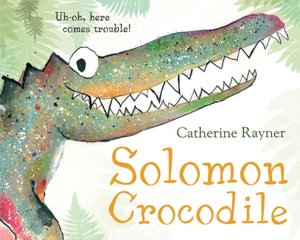
Linked to Read-Aloud Thursday at Hope Is the Word where you will find a lot more great books!
Categories:
Alphabet,
Biography,
Books,
Elementary,
Fiction,
History,
Nonfiction,
Picture Books,
Preschool,
Read Aloud
When the Weather Outside is Cold

When the January wind starts to blow, and we are driven inside from the cold, it is a great time to learn how animals and people survive and thrive in the colder areas of the globe. Three books our children have read (or were read aloud) are:
Survival at 40 Below, by Debbie S. Miller, describes life just north of the Arctic Circle in Alaska's Gates of the Arctic National Park and Preserve. The book begins in autumn. Animals are scurrying to prepare for the next eight months of winter. Miller explains how a wide variety of animals get ready for snow and survive cold winter temperatures. We were fascinated by the frog freezing and the squirrel's cyclic hibernation. Another interesting tidbit we learned was about a caterpillar that spends 14 winters in the caterpillar phase and after those years, just one summer as a moth. The book concludes with an author's note explaining her inspiration behind the book and a glossary defining possible unfamiliar terms.
Another book set in an Arctic winter is Welcome to the Ice House, by Jane Yolen. A plethora of animals from land to sea who find homes in the frigid Arctic winter are presented. Lovely illustrations by Laura Regan set a tranquil tone and the lyrical text creates a melodious read aloud. A final page entitled "Did You Know?" explains the origin of the term 'arctic' and offers the University of Alaska Museum website address for more information.
For a different perspective on the cold, the book Antler, Bear, Canoe: A Northwoods Alphabet Year, by Betsy Bowen depicts life in the northwoods of Minnesota. While moving through the alphabet, Bowen shares a bit about the northwoods from January to December. Each entry portrays an activity, observation, or incident from the author's life. This provides readers with a more personal connection with life in the northwoods. The wood block illustrations lend to the rustic appeal of the book.
Other books set in the Arctic or cold, winter time:
In the Far North, by Lola Kamalova
Arctic Son, by Jean Craighead George
The Long Winter, by Laura Ingalls Wilder
Adventures of an Arctic Missionary series, by Gloria Repp
Trapped by the Mountain Storm, by Aileen Fisher
Snowflake Bentley, by Jacqueline Briggs Martin
Tikta'Liktak: An Inuit-Eskimo Legend, retold by James Houston
Categories:
Alphabet,
Books,
Elementary,
Geography,
Nonfiction,
Picture Books,
Preschool,
Science
Early Learning: Math Manipulatives
By the fourth child, I started introducing math manipulatives at an earlier age. This is not to advance the child academically or cause undo stress, but simply, to offer a varied learning experience and exploration. This has also helped promote interest in math from an early age.
Today, I am sharing what my preschooler is currently using. However, the older children have typically played and learned with math manipulatives through the second or third grade.
Using our number cards (bought on clearance for a calendar we do not have), our preschooler puts numbers in order, chooses a corresponding number to reflect how many are in a group, learns concepts like greater than and less than, and plays a 'what number is missing?' game.
{How we play the What Number Is Missing? game: He puts the numbers in order, and I remove one or two while he is turned around. He turns and guesses what number(s) are missing.}
These peg boards and rubber bands from our early elementary Saxon Math manipulative kit are a hit with all the children. Our youngest made these designs one day:
From the same kit, we have a bag full of teddy bears. These are used with the curriculum for acting out addition and subtraction problems, but our preschooler likes them for graphing.
Overall, for our family, math manipulatives, those we have made and those we have bought, have been worth the time and investment. Our children learn abstract concepts more easily after they have seen and experienced them with manipulatives.
Today, I am sharing what my preschooler is currently using. However, the older children have typically played and learned with math manipulatives through the second or third grade.
Using our number cards (bought on clearance for a calendar we do not have), our preschooler puts numbers in order, chooses a corresponding number to reflect how many are in a group, learns concepts like greater than and less than, and plays a 'what number is missing?' game.
{How we play the What Number Is Missing? game: He puts the numbers in order, and I remove one or two while he is turned around. He turns and guesses what number(s) are missing.}
These peg boards and rubber bands from our early elementary Saxon Math manipulative kit are a hit with all the children. Our youngest made these designs one day:
From the same kit, we have a bag full of teddy bears. These are used with the curriculum for acting out addition and subtraction problems, but our preschooler likes them for graphing.
Overall, for our family, math manipulatives, those we have made and those we have bought, have been worth the time and investment. Our children learn abstract concepts more easily after they have seen and experienced them with manipulatives.
Categories:
Hands On Learning,
Math,
Preschool
Through the Year(s) with Books
The concept of time can be hard to grasp when you are only a handful or so years old. However, there are some amazing picture books with great story lines that help convey the concept of time to youngsters. I've compiled a listing of our favorite books from our very own shelves, that help develop a sense of time.
Books Spanning One Year of Time
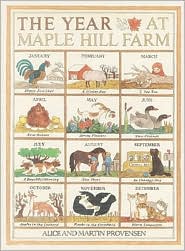 Trace time and seasons with the farm animals of The Year at Maple Hill Farm, by Alice and Martin Provensen.
Trace time and seasons with the farm animals of The Year at Maple Hill Farm, by Alice and Martin Provensen.
Written by Harriet Ziefert, this year long story follows Anna and her mother as they resourcefully get A New Coat for Anna.
The story of the Ox-Cart Man, by Donald Hall, spans a year in the life of a hard working New Hampshire family of the nineteen century.
A more whimsical tale is found in Frog and Toad All Year, by Arnold Lobel. We are always amused by the mishaps and adventures of these two lovable friends.
Filled with folk art and memoir excerpts of Grandma Moses, The Year with Grandma Moses, by W. Nikola-Lisa transports the reader to a simpler era filled.
Books Spanning Multiple Years

The Little House, by Virginia Lee Burton, tells an endearing tale of urbanization through the eyes of a little home on a hill.
Generations are tied together with The Keeping Quilt in the story by Patricia Polacco.
Then and Now, an Usborne book by Heather Amery uses places of interest to demonstrate change over time. Readers visually observe the changes through time to stores, countryside, home life, and railroad stations.
Ever wonder what changes are brought about when a farm is left idle? Find out how over many years, an unused farm turns into a forest while reading McCrephy's Field, by Christopher A. Myers and Lynne Born Myers.
Linked to Read-Aloud Thursday at Hope Is the Word
Books Spanning One Year of Time
 Trace time and seasons with the farm animals of The Year at Maple Hill Farm, by Alice and Martin Provensen.
Trace time and seasons with the farm animals of The Year at Maple Hill Farm, by Alice and Martin Provensen.Written by Harriet Ziefert, this year long story follows Anna and her mother as they resourcefully get A New Coat for Anna.
The story of the Ox-Cart Man, by Donald Hall, spans a year in the life of a hard working New Hampshire family of the nineteen century.
A more whimsical tale is found in Frog and Toad All Year, by Arnold Lobel. We are always amused by the mishaps and adventures of these two lovable friends.
Filled with folk art and memoir excerpts of Grandma Moses, The Year with Grandma Moses, by W. Nikola-Lisa transports the reader to a simpler era filled.
Books Spanning Multiple Years

Generations are tied together with The Keeping Quilt in the story by Patricia Polacco.
Then and Now, an Usborne book by Heather Amery uses places of interest to demonstrate change over time. Readers visually observe the changes through time to stores, countryside, home life, and railroad stations.
Ever wonder what changes are brought about when a farm is left idle? Find out how over many years, an unused farm turns into a forest while reading McCrephy's Field, by Christopher A. Myers and Lynne Born Myers.
Linked to Read-Aloud Thursday at Hope Is the Word
Categories:
Books,
Elementary,
Picture Books,
Preschool,
Read Aloud
Christmas Joy - Read Alouds
A few weeks ago, I shared that our local library has many Christmas books, and I wrote about the historical selections we were reading. Yesterday, I shared the wide selection of beautifully illustrated Christmas carols we found. Today, I'd like to share a few heart tugging Christmas books we found at that very same library. I told you, Love that library!
Heart Tuggers

Coal Country Christmas, written by Elizabeth Ferguson Brown, tells about Liz visiting her grandmother for Christmas in the Appalachian Mountains of Pennsylvania. Her experiences and thoughts throughout the story are simply expressed, just as a child would retell it. Though the emotion is vital to the story line, in a way, it is quite understated and children may not even pick up on it. However, grown ups will certainly not miss the sense of loss intertwined with the family joy and traditions.
Another book entitled Just in Time For Christmas, by Louise Borden tells of Will, a boy living with his family and Great-Gram in Kentucky. The main story line our children remembered were Will's dog missing just days before Christmas as the extended family gathers at Will's house for a Christmas celebration that includes making pulled candy. Although present, our children vaguely picked up on Will's great-grandma's fading memory, and how she continually calls him by the wrong name. Again, the sorrow intermixes with the joy of celebrating the holiday together.
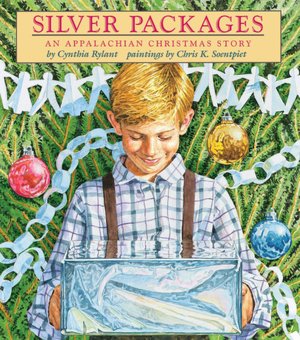
Every year, the Christmas Train arrives bringing presents to all eagerly awaiting boys and girls. And, each year, Frankie hopes for one particular gift: a doctor kit. Year after year, Frankie receives various gifts, including mittens, warm socks, and toys, but never a doctor kit. Years later, as Frankie has grown into a man and is living far away, he thinks back to all his blessings. He decides to move back to the Appalachian Mountains to help those who live there. I won't give away the ending, but definitely if you can only read one of these books this Christmas season, might I encourage it to be this one? For Silver Packages: An Appalachian Christmas Story, by Cynthia Rylant is that good.
We also read Great Joy, by Kate DiCamillo. Frances, a little girl, lives in the city. One day, she notices a man and his pet monkey. He is an organ grinder, who plays his music while the monkey holds a cup for offerings. Frances begins to wonder about the man and where he goes at night, when she sees him late one night on the street. It is a poignant story of a little girl's compassion. Though it serves as a contrast, I was disappointed by the mother's indifference.
Finally, two books by Patricia Polacco must be included in this list of heart tugger Christmas read alouds.
The first, Christmas Tapestry, was definitely one to read with the tissue box handy. {Thanks Mary for the heads-up!} This sweet book begins with a family's move to Detroit, and ends with seemingly insignificant and significant events tied together in the beautiful tapestry of life.
The second Polacco book we read was An Orange for Frankie. A wonderful family tale unfolds of Christmas time in the Stowell household. Frankie, along with his family, share what they have with those in need as they anxiously await Pa's return. When he returns, he will bring a crate of oranges with him. The oranges are a traditional part of Christmas for the family and are greatly anticipated. However, poor weather delays Pa, and the family must go about the Christmas preparations without him. The train stops behind their home, and with it comes a group of hobos who are fed and cared for by the family. Frankie notices one man has only a thin overcoat. He runs to his room and retrieves his best sweater, the only one that will fit the man. Quickly, he gives it to the man. I don't want to spoil how Frankie's generosity is rewarded, but it is in a sweet way...
And, yes,...we did share a few slices of tasty oranges while reading this book.
Linked to Read-Aloud Thursday at Hope Is the Word
Heart Tuggers

Coal Country Christmas, written by Elizabeth Ferguson Brown, tells about Liz visiting her grandmother for Christmas in the Appalachian Mountains of Pennsylvania. Her experiences and thoughts throughout the story are simply expressed, just as a child would retell it. Though the emotion is vital to the story line, in a way, it is quite understated and children may not even pick up on it. However, grown ups will certainly not miss the sense of loss intertwined with the family joy and traditions.
Another book entitled Just in Time For Christmas, by Louise Borden tells of Will, a boy living with his family and Great-Gram in Kentucky. The main story line our children remembered were Will's dog missing just days before Christmas as the extended family gathers at Will's house for a Christmas celebration that includes making pulled candy. Although present, our children vaguely picked up on Will's great-grandma's fading memory, and how she continually calls him by the wrong name. Again, the sorrow intermixes with the joy of celebrating the holiday together.

Every year, the Christmas Train arrives bringing presents to all eagerly awaiting boys and girls. And, each year, Frankie hopes for one particular gift: a doctor kit. Year after year, Frankie receives various gifts, including mittens, warm socks, and toys, but never a doctor kit. Years later, as Frankie has grown into a man and is living far away, he thinks back to all his blessings. He decides to move back to the Appalachian Mountains to help those who live there. I won't give away the ending, but definitely if you can only read one of these books this Christmas season, might I encourage it to be this one? For Silver Packages: An Appalachian Christmas Story, by Cynthia Rylant is that good.
We also read Great Joy, by Kate DiCamillo. Frances, a little girl, lives in the city. One day, she notices a man and his pet monkey. He is an organ grinder, who plays his music while the monkey holds a cup for offerings. Frances begins to wonder about the man and where he goes at night, when she sees him late one night on the street. It is a poignant story of a little girl's compassion. Though it serves as a contrast, I was disappointed by the mother's indifference.
Finally, two books by Patricia Polacco must be included in this list of heart tugger Christmas read alouds.
The first, Christmas Tapestry, was definitely one to read with the tissue box handy. {Thanks Mary for the heads-up!} This sweet book begins with a family's move to Detroit, and ends with seemingly insignificant and significant events tied together in the beautiful tapestry of life.
The second Polacco book we read was An Orange for Frankie. A wonderful family tale unfolds of Christmas time in the Stowell household. Frankie, along with his family, share what they have with those in need as they anxiously await Pa's return. When he returns, he will bring a crate of oranges with him. The oranges are a traditional part of Christmas for the family and are greatly anticipated. However, poor weather delays Pa, and the family must go about the Christmas preparations without him. The train stops behind their home, and with it comes a group of hobos who are fed and cared for by the family. Frankie notices one man has only a thin overcoat. He runs to his room and retrieves his best sweater, the only one that will fit the man. Quickly, he gives it to the man. I don't want to spoil how Frankie's generosity is rewarded, but it is in a sweet way...
And, yes,...we did share a few slices of tasty oranges while reading this book.
Linked to Read-Aloud Thursday at Hope Is the Word
Categories:
Books,
Christmas,
Elementary,
Fiction,
Picture Books,
Preschool,
Read Aloud
Christmas Around the World Resources
Hoping to teach our children about how Christmas is celebrated elsewhere in the world, I searched for resources. A few of the favorite books we found are...
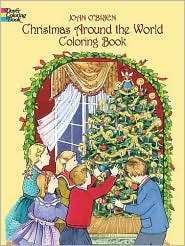 Christmas Around the World Coloring Book, by Joan O'Brien, is a book full of coloring pages highlighting Christmas celebrations world wide. It also offers short descriptions of each country's unique traditions on every page.
Christmas Around the World Coloring Book, by Joan O'Brien, is a book full of coloring pages highlighting Christmas celebrations world wide. It also offers short descriptions of each country's unique traditions on every page.
Christmas Around the World, written by Emily Kelley is a small picture book my oldest son and I found on a recent library trip. Kelley explores Christmas traditions of eight different countries. Some of the countries are Mexico, China, and Iran. The customs highlighted within the book are fascinating to read. We learned about the traditions of Christians in Iraq and the Festival of Light in Sweden.
Another picture book we found on that same library visit was The Christmas Drum, by Maureen Brett Hooper. Peter, a young boy living in a small village in Romania, anticipates playing the duba (a drum) for the caroling on Christmas Eve. Peter's father is working in the city and unable to play with the group. Peter takes his place. For the entire evening, Peter plays the drum well, and even sings a carol all by himself.
For a more local selection, we read An Amish Christmas, by Richard Ammon. The book begins with a group of Amish children preparing and performing a Christmas program at their one room school house on Christmas Eve day. Christmas day is celebrated with family, food, and fun. The following day, The Second Day of Christmas is celebrated.
Perhaps, if we have time, we will finally travel to the National Christmas Center for a tour highlighting world wide Christmas traditions of past and present.
 Christmas Around the World Coloring Book, by Joan O'Brien, is a book full of coloring pages highlighting Christmas celebrations world wide. It also offers short descriptions of each country's unique traditions on every page.
Christmas Around the World Coloring Book, by Joan O'Brien, is a book full of coloring pages highlighting Christmas celebrations world wide. It also offers short descriptions of each country's unique traditions on every page.Christmas Around the World, written by Emily Kelley is a small picture book my oldest son and I found on a recent library trip. Kelley explores Christmas traditions of eight different countries. Some of the countries are Mexico, China, and Iran. The customs highlighted within the book are fascinating to read. We learned about the traditions of Christians in Iraq and the Festival of Light in Sweden.
Another picture book we found on that same library visit was The Christmas Drum, by Maureen Brett Hooper. Peter, a young boy living in a small village in Romania, anticipates playing the duba (a drum) for the caroling on Christmas Eve. Peter's father is working in the city and unable to play with the group. Peter takes his place. For the entire evening, Peter plays the drum well, and even sings a carol all by himself.
For a more local selection, we read An Amish Christmas, by Richard Ammon. The book begins with a group of Amish children preparing and performing a Christmas program at their one room school house on Christmas Eve day. Christmas day is celebrated with family, food, and fun. The following day, The Second Day of Christmas is celebrated.
Perhaps, if we have time, we will finally travel to the National Christmas Center for a tour highlighting world wide Christmas traditions of past and present.
Categories:
Books,
Christmas,
Elementary,
Holidays,
Nonfiction,
Picture Books,
Preschool,
Teacher Resources
Water, Ocean, and Coral Reefs
Over the past dozen or so weeks, I have taught ocean life in our Wednesday science co-op class. I was blessed to use another teacher's lesson plans for the majority of classes, and only had to write lesson plans for three classes. {a class on water, another on oceans in general, and one on oceanic food webs} However, I was not able to find all the reference books and read aloud books she had used. Each week, I trekked to our local library in search of suitable books to read aloud. Thankfully our library had a large selection of books on most of the topics we covered in class.
Some of the children's favorite read alouds were...
This is the Ocean, by Kersten Hamilton
The Magic School Bus on the Ocean Floor, by Joanna Cole
The Magic School Bus Takes a Dive, by Joanna Cole
What Lives in a Colorful Coral Reef? by Rachel Lynette
About Crustaceans, by Cathryn Sill
Crab, by Lloyd G. Douglas
Hello Fish! Visiting the Coral Reef, by Sylvia A. Earle
Mister Seahorse, by Eric Carle
Whale Shark: The World's Biggest Fish, by Meish Goldish
Wish for a Fish: All About Sea Creatures, by Bonnie Worth
Related:
An Ocean Lesson
A Wet Lesson on Water
Coral Reef Dioramas
Some of the children's favorite read alouds were...
This is the Ocean, by Kersten Hamilton
The Magic School Bus on the Ocean Floor, by Joanna Cole
The Magic School Bus Takes a Dive, by Joanna Cole
What Lives in a Colorful Coral Reef? by Rachel Lynette
About Crustaceans, by Cathryn Sill
Crab, by Lloyd G. Douglas
Hello Fish! Visiting the Coral Reef, by Sylvia A. Earle
Mister Seahorse, by Eric Carle
Whale Shark: The World's Biggest Fish, by Meish Goldish
Wish for a Fish: All About Sea Creatures, by Bonnie Worth
Related:
An Ocean Lesson
A Wet Lesson on Water
Coral Reef Dioramas
Categories:
Books,
Creation,
Elementary,
Nonfiction,
Ocean,
Picture Books,
Preschool,
Read Aloud,
Science
Location, Location - Read Alouds Set in Maine
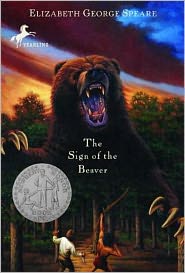 We've read it before. About four years ago, when we first studied this time period in history, we followed another's recommendation to read The Sign of the Beaver, by Elizabeth George Speare. It did not disappoint. Though our children were young, the exciting story line captured their attention. This time, reading through the book, the children and I are appreciating the character development, interaction, and struggles.
We've read it before. About four years ago, when we first studied this time period in history, we followed another's recommendation to read The Sign of the Beaver, by Elizabeth George Speare. It did not disappoint. Though our children were young, the exciting story line captured their attention. This time, reading through the book, the children and I are appreciating the character development, interaction, and struggles. The Sign of the Beaver takes place in the Maine wilderness during the 1700's. Matt, a twelve-year-old, is left alone at his family's cabin while his father travels to bring his mother and siblings to the new settlement. The situations and people Matt meets while living alone are interesting and bring the time period to life. It fabulous to read aloud, whether the first time or second time. For those wondering what reading level this book is, I would consider it 4th to 6th grade level.
Other titles we have read aloud that are set in Maine are Calico Bush, Blueberries for Sal, and One Morning in Maine.
Calico Bush, written by Rachel Field, takes place during the 1740's in a northern part of Maine. The area where the Sargent family settles is quite isolated. However, the location is not the only reason Marguerite feels lonely. She has lost her family and now lives with the Sargent family as a servant. Neither the family nor the area feels like home to Marguerite. The story line is poignant, and thirteen-year-old Marguerite's courage and inner strength are admirable. The book is great for independent readers in grades 5th to 8th.
Both Blueberries for Sal and One Morning in Maine are written by Robert McCloskey. Each is a fabulous short story to read aloud to preschoolers or early elementary aged children. Our favorite of the two is Blueberries for Sal. After all, who doesn't love when Sal follows the momma bear and baby bear follows Sal's momma around on the blueberry hill?
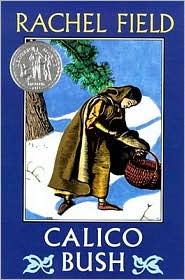
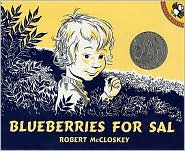
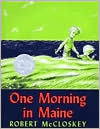
To find more read aloud selections, visit Amy at Hope Is the Word
for this week's Read-Aloud Thursday link up.
Categories:
Books,
Elementary,
Fiction,
Historical Fiction,
Middle School,
Picture Books,
Preschool,
Read Aloud
Practicing Being Still
Every week, I teach a science class to a group of children ranging from preschool to third grade. The class lasts two hours. The children are wonderfully inquisitive about every topic. In fact, it is very easy to teach such curious students. However, it is not always so easy for them to contain their exuberance.
Some weeks, their energy level is quite high and sitting still is hard, even after a few move about activities. SO, they have take to a little friendly competition among themselves.
During the short read aloud book, they play a little game, a sitting still kind of game. Whoever sits the stillest gets rewarded by being served snack first. Amazingly, this small incentive and the ensuing 'bragging rights' motivate them all to sit still while I read aloud. They do not have to stay completely still. In fact, I encourage discussion and questions during the reading.
Oddly enough, on days when I don't think the game is necessary, they still ask to play, and we do.
Some weeks, their energy level is quite high and sitting still is hard, even after a few move about activities. SO, they have take to a little friendly competition among themselves.
During the short read aloud book, they play a little game, a sitting still kind of game. Whoever sits the stillest gets rewarded by being served snack first. Amazingly, this small incentive and the ensuing 'bragging rights' motivate them all to sit still while I read aloud. They do not have to stay completely still. In fact, I encourage discussion and questions during the reading.
Oddly enough, on days when I don't think the game is necessary, they still ask to play, and we do.
Categories:
Co-op,
Elementary,
Preschool,
Science,
Teacher Resources
Textured Owl Craft
After reading Whoo-oo Is It? by Megan McDonald, our youngest wanted to "make an owl."
I thought it might be a good opportunity to use up some of our miscellaneous craft supplies and devised this craft for him to do.
Supplies
cardboard (we used the back of an empty 8x11 paper pad)
blue tissue paper
tan thin foam
triangular piece of brown thin foam (for beak)
feathers
two stones
brown rice
orange cording
glue (white and tacky)
foam brush
Method
1. rip blue tissue paper up into smaller sized shapes (our son loved this part)
2. spread glue over cardboard with foam brush
3. place blue tissue papers in collage form all over cardboard
4. coat the top of tissue paper with more glue
5. allow to dry
6. draw (grown-up) and cut out an owl shape from the tan thin foam sheet
7. affix with glue to blue background
8. glue rocks as eyes and triangle as beak
9. coat face of owl with glue
10. spoon rice onto face
11. squeeze a line of glue around the face and affix orange cording around face
12. using tacky glue attach feathers
13. using white glue coat rest of owl body and spoon rice over glue
14. pat rice down, then shake off excess
15. allow to dry
Inspiration art work found within our read aloud.
Categories:
Art,
Elementary,
Extension Activity,
Preschool
Encouraging Them to Read History Related Books
It's no secret. We have lots of books in our home.
Some are ours, but a lot we borrow from friends and local libraries.
Each year, as we progress through history in a four year cycle, I try to find a variety of children's books set in, or about the time period we are studying. This is harder for ancient history, but quite easy for our current time period (1400's/1500's to 1850).
Due to the over abundance of selections, I started a new system this year. I still read aloud several selections to the children, but the extra books get placed in a basket. Each child is encouraged to read a few extra books each week.
To further encourage them, I made a graph that records each child's progress. We have four children with four different reading and comprehension abilities. To make it fair, we set guidelines for how many books must be read for each particular child to color a box.
Our guidelines:
7th grader - read 4 picture books / color 1 box; read 1 chapter book / color 1 box
5th grader - read 2 picture books / color 1 box; read 1 chapter book / color 2 boxes
3rd grader - read 1 picture book / color 1 box; read 1 chapter book / color 4 boxes
Preschooler - listen to 1 picture book / color 1 box
Eventually, we will add some incentive prizes,
but for now, we are simply implementing the system.
Categories:
Books,
Elementary,
Historical Fiction,
History,
Middle School,
Preschool
Don Quixote - A Picture Book Version
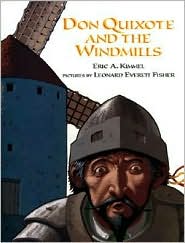 For history class, we are studying 1400's/1500's to 1850 over the course of this school year. Typically, our read aloud selections focus on historical accounts, literature, or biographies from this time period. At times, we will read an unrelated selection, but for the most part, our selections center around our history studies.
For history class, we are studying 1400's/1500's to 1850 over the course of this school year. Typically, our read aloud selections focus on historical accounts, literature, or biographies from this time period. At times, we will read an unrelated selection, but for the most part, our selections center around our history studies. This past week, I found Don Quixote and the Windmills, by Eric A. Kimmel at our local library. It is picture book retelling a short portion of Miguel de Cervantes Saavedra's original Don Quixote. The illustrations are bold and perfect to share with a small group of listeners. The text is fabulous to read aloud. It combines suspense and humor. Our children were delighted, even our oldest who read Adventures of Don Quixote, by Argentina Palacios, earlier this year.
To find out about more read aloud selections, visit Amy at Hope Is the Word
for this week's Read-Aloud Thursday link up.
Categories:
Books,
Elementary,
Literature,
Picture Books,
Preschool,
Read Aloud
Subscribe to:
Posts (Atom)



































